Intel's Xeon D Product Family Updated with Storage and Networking-Specific SKUs
by Ganesh T S on November 9, 2015 6:45 PM EST- Posted in
- Enterprise
- Storage
- Networking
- Intel
- Xeon-D
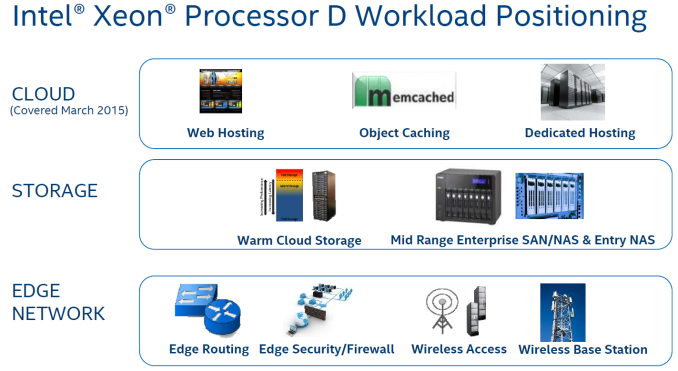
Intel's Xeon D has been one of the most exciting platforms to come out of Intel this year. Xeon D has created more excitement in the micro-server / edge server market compared to the introduction of Avoton and Rangeley (based on Silvermont x86 Atom cores) a few years back. In introducing the 22nm Atom-based server SoCs, Intel clearly delineated different SKUs for different market segments. While Avoton (C2xx0) concentrated on the storage server market, Rangeley (C2xx8) added some communication accelerators that made it a good fit for networking and communication applications.
Xeon D was launched with two SKUs (D1520, a 4C/8T SiP, and the D1540, a 8C/16T SiP) earlier this year. While those two SKUs covered the web hosting applications, today's launches cover the storage and edge network applications. Intel's slide from a presentation made earlier today sums up the various products in the lineup. Eight new Xeons and three new Pentium processors are being launched in the D-1500 lineup and they come in both 45W and 35W TDP versions. Interestingly, Intel indicated that 12-core and 16-core Xeon D SiPs can be expected early next year.
Note: The Pentium D Processors indicated in the above slide were not launched despite being part of the slide set. Currently, there are a total of 10 Xeon-D SKUs (as of Q4 2015).
Patrick at ServeTheHome has a nice graphic summarizing the clock speeds and pricing of these products. The D15x1 SKUs target the storage market, while the D15x7 and D15x8 target the networking / communication segments.
Intel claims that the new storage SKUs provide as much as 6x the performance of the high-end Avoton-based platforms.
Intel's Storage Acceleration Library (ISA-L) provides accelerators for compression, checksumming, parity calculation and cryptograhic functions (encryption as well as hashing).
The Storage Performance Development Kit (SPDK) provides better optimization compared to the native Linux drivers - particularly as the number of storage devices in the system ramps up.
On the networking front, Intel claims up to 5.4x higher performance compared to the Rangeley-based platforms. Intel is promoting their Data Plane Development Kit (DPDK) to achieve better performance for L3 packet forwarding, VM packet forwarding with Open vSwitch, and IPSec forwarding (VPN applications).
ServeTheHome talks about how the communication accelerators have gained extensive software support since they were launched with the Rangeley SoCs in 2013.
One of the disappointing aspects with respect to the D1520 and D1540 (at least for those intending to use them as virtualization hosts) was the pulling back of the advertised SR-IOV feature. It remains to be seen if the new SKUs have the feature enabled.
In addition to the new Xeon D SKUs, Intel also announced the FM10000 Ethernet multi-host controller family that can provide up to 36 Ethernet lanes. The FM10000 family supports 1Gbps, 2.5Gbps, 10Gbps, and 25Gbps Ethernet ports and the ability to group four lanes as 40Gbps or 100Gbps ports. The integrated Ethernet controllers can be configured as four 50Gbps or eight 25Gbps host interfaces,.
The new X550 single-chip, low-cost 10GbE platform was also launched. It supports NBASE-T technology (for 2.5Gbps as well as 5 Gbps operation, in addition to 10Gbps).
Operating via a PCIe 3.0 x1 / x4 / x8 link, the new 10GBASE-T controller integrates both MAC and PHY in a single package, and comes in both single and dual-port varieties. Power consumption is just 11 W with both 10GbE ports active, making it amenable to passive heatsink thermal solutions.
Source: Intel


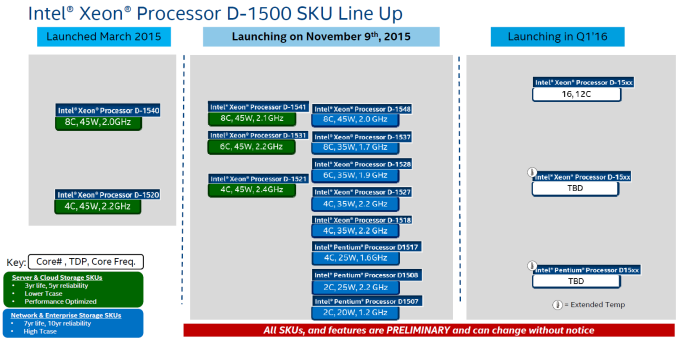
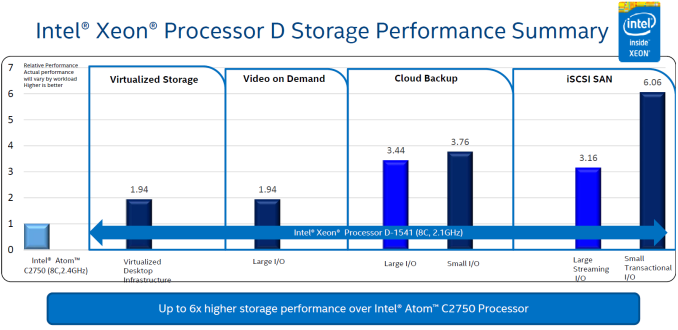
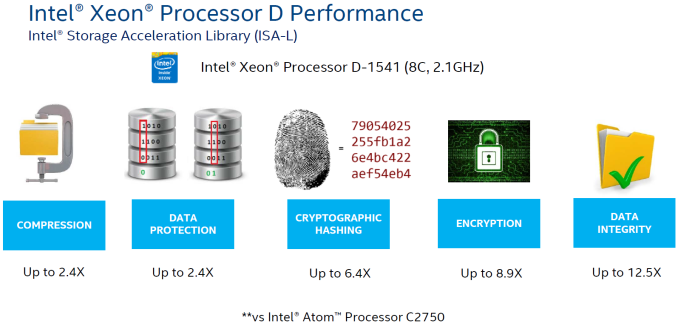
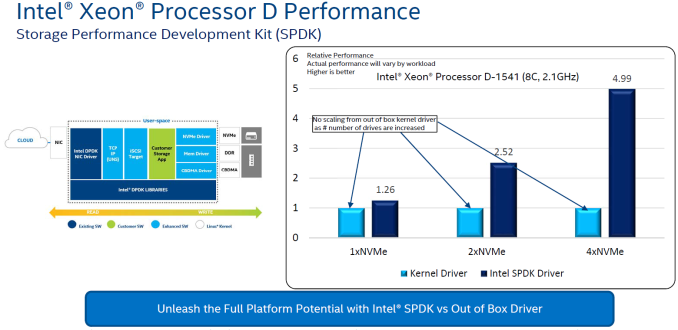
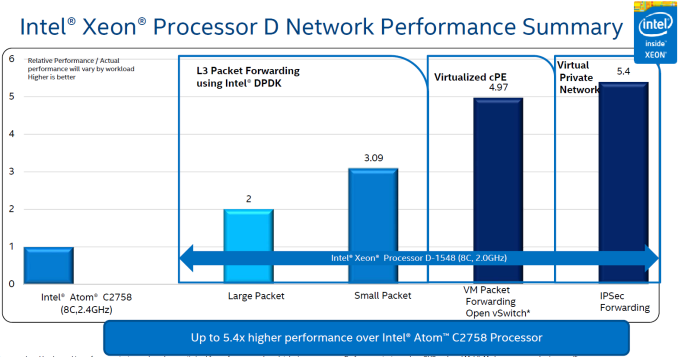
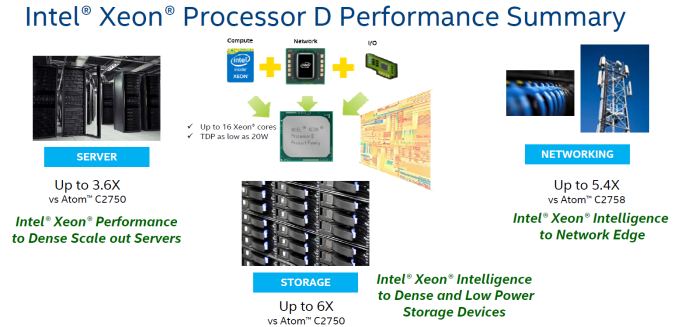

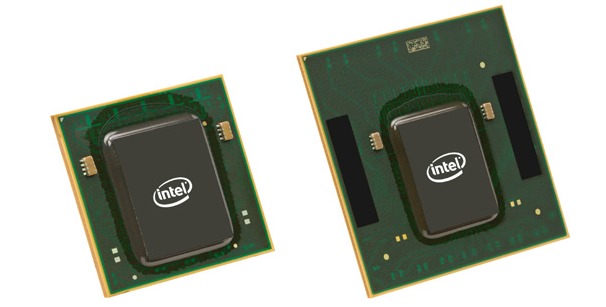








17 Comments
View All Comments
Gigaplex - Monday, November 9, 2015 - link
Definitely interested in the X550 ethernet platform. Home networks have been stagnating for too long on 1Gbps, so the ability to run at 2.5Gbps and 5Gbps is helpful when it's not practical to go all in on 10Gbps (eg, existing wiring using Cat5E).DigitalFreak - Monday, November 9, 2015 - link
Question is when 2.5 / 5Gbps switches will be available at a reasonable price point.bill.rookard - Monday, November 9, 2015 - link
Indeed. Or 10Gb parts which at least are semi-standard in enterprise applications. Those have been incredibly slow to trickle down.dgingeri - Monday, November 9, 2015 - link
So far, I've only been able to find the X550 line (X552 specifically) as an embedded solution. I have not seen a separate card for it yet. I'm in a position to see such things even before they come out. I'm the admin of several server hardware and software test labs.Our equipment is still using the X540 for 10Gbase-T, and we tried the new X710 months ago for our 10Gbase-SR connectivity. (Turns out the X710 has issues corrupting data and dropping packets at high utilization, across all operating systems. No driver could fix it. So, we went back to the X520, and I'm stuck with 16 X710 cards sitting in my storage cage that will probably never get used.)
I do hope the X550 will become available on a card, rather than just motherboard products. It would likely be cheaper than the X540.
nils_ - Tuesday, November 10, 2015 - link
Couldn't you just return the faulty X710?iwod - Monday, November 9, 2015 - link
Exactly my thought. We have AC5300 now, we will have True 8x8 MIMO 10Gbps from Quantenna next year. ( May be marketed as 802.11ac Wave 3 ). 2017-2018 we should see Draft 802.11ax, and 2020 a 8x8 802.11ax design will be 30Gbps++.Even though you may only get 50% of Wireless theoretical speed, we can already see Wireless speed soon be faster then Wire speed. Since we are much quicker at replacing our Wireless equipment then rewiring a building. Why is it the industry have yet to act on? It is clear the 2.5Gbps and 5Gbps NBase-T are stop gap solution only. I just checked on Wiki 10-BASE-T was actually defined in 2006, that is nearly 10 years ago. Why haven't PC, Home Router moved on to 10Gbps?
FalconSteve - Sunday, February 21, 2016 - link
Do most home users need 10Gbps? My brand new laptop has dual band Wifi (2.4Ghz & 5Ghz 802.11ac) and a difficult to connect 100Mbps port and I rarely care that it is only "Fast Ethernet", although I need the GbE that is on my desktop. Gigabit only made it to mainstream in the past 2-3 years. My old laptop wasn't so thin, so it had a standard Ethernet port and I did hard-wire it in my living room and bedroom (rooms were I use my laptop most and the rooms that I have GbE switches with unused ports). It is/was also "Fast Ethernet".I bond backbones in my home to achieve 2Gbps full duplex (my wifi is 1.9Gbps half-duplex) and my FreeNAS and WD EX4 have dual GbE, but they rarely use it (I dropped the second GbE on the EX4 from my home network and connected it to an old router running DD-WRT in client mode so that my next door neighbor can watch my MASSIVE TV and movie collection via DLNA).
When I transfer files in Windows using SMB/CIFS/Samba, I get about 10-12MB/s (80-96mbps) per stream and occasionally, when concurrently sending and receiving from multiple drives or using USB3.0 flash drives, I get 24-30MB/s (192-240Mbps) (depending on the number of streams and sources) total maximum throughput whether I am on GbE or 5GHz Wifi.
I believe that there is about 20% protocol overhead, so GbE should deliver 800Mbps or 100MB/s, but I never see those speeds.
My 5Ghz connection on my EA6500 is theoretically capable of 1.3Gbps half-duplex and the advertised total throughput is 1.9Gbps. That is roughly equal to two bonded GbE if the data is all going one direction or one if equal data is going each way. Even the 1.3Gbps 5Ghz alone exceeds the GbE speed in one direction (when I need speeds exceeding 100mbps, it is almost exclusively unidirectional). However, I average 200Mbps with the built in wireless card.
In short, Gigabit Ethernet doesn't seem to be the botteneck, so...
Why haven't PCs, switches, and home routers moved to 10Gbps?
1) cost of 10GbE NICs (which is effected by economies of scale)
1b) cost of 10GbE switches (including routers)
2) it isn't needed (yet) since GbE isn't the bottleneck
3) 10GbE requires more expensive wiring that the CAT5e or CAT6
4) 10GbE wiring is more fragile than CAT5e or CAT6
5) More and more devices are being connected wirelessly in the home
5a) Cell phone, tablets, netbooks, some printers & multi-function devices (printer, scanner, copier, fax), and some "smart" TVs don't even offer Ethernet connections
6) Wireless bandwidth is shared, ethernet is not
6a) A half-duplex 1.9Gbps wireless network only allows 1.9Gbps to move TOTAL (5Ghz offers SIGNIFICANTLY more non-overlapping channels than 2.4Ghz, so with multiple APs and channels, you can increase this, but there are limits unique to wireless)
6b) Each of my 8-port GbE switches have a total switching capacity of 16Gbps
6b2) Even with 2 ports on each of the managed 8 port switches being used as bonded backbones between each other and single GbE connection between one of them and the router and an unmanaged 8 port switch with one connection to the router, that leaves, 3 usable ports on the router (6Gbps), 5 open ports of managed switch 1 (10Gbps), 6 open ports on managed switch 2 (12Gbps), and 7 open ports of my unmanaged switch (14Gbps usable). So, My GbE with 2 DD-WRT routers (one acting as a switch/AP combo) and 3 switches offers 58Gbps total switching capacity, 42-46 of which is available to devices (depending on whether or not bonding is used). I also have a D-Link 2.4/5Ghz router with 5 GbE ports that I use as a combination AP & switch, which has a 10Gbps wired switching capacity (8Gbps open when hardwired to the network, but it does occupy one port on the switch, so it effectively adds another 6Gbps device capacity to the network, making those 5 devices 68Gbps, with 50-54Gbps device available). A 24 port GbE switch has a switching capacity of 48gbps. That is SIGNIFICANTLY more wired bandwidth than ANY wireless solution offers. AC530 is NOT 5.3Gbps half-duplex per device. I would be shocked if it reached 2 Gbps half duplex and I am sure you're neighbors share some of that bandwidth,
6c) My EA6500 offers 8Gbps wired LAN bandwidth (10Gbps including the WAN port, which DD-WRT can assign to the switch- My, and many other, ISPs offer Wifi modem/router combos, which can connect your internet (which are usually inconveniently placed and don't need your full 100mbps connections to your router, much less Ethernet).
That being said, if I was offered a free 24 port 10GbE switch, an ample variety of 10GbE pre-made cables, OF COURSE I would accept and love them, but GbE in the home really is adequate.
pjkenned - Monday, November 9, 2015 - link
Hey Ganesh - this is Patrick from ServeTheHome -One minor note is that the Xeon D-1507, D-1508 and D-1517 in the slide you posted were not launched today. Also - not in that table are the storage optimized SKUs.
Feel free to take the table from the STH post if you want to replace.
pjkenned - Monday, November 9, 2015 - link
D'oh - ok the storage SKUs are on the left side in that column. But the last three in the middle-right were not released today.ganeshts - Monday, November 9, 2015 - link
Thanks, Patrick! I am waiting for updated slides from PR..